Exploring the Link Between Smoothies and Obesity: Research for Food and Nutrition
VerifiedAdded on 2023/04/24
|12
|3787
|408
AI Summary
In this document we will discuss about Research for Food and Nutrition and below are the summary points of this document:-
Smoothies are being examined for their potential role in the rise of obesity.
The study evaluates the consumption of smoothies containing dairy products and their impact on obesity.
Green smoothies, made with fruits, leafy greens, and water, are found to help prevent obesity and improve overall health.
Contribute Materials
Your contribution can guide someone’s learning journey. Share your
documents today.
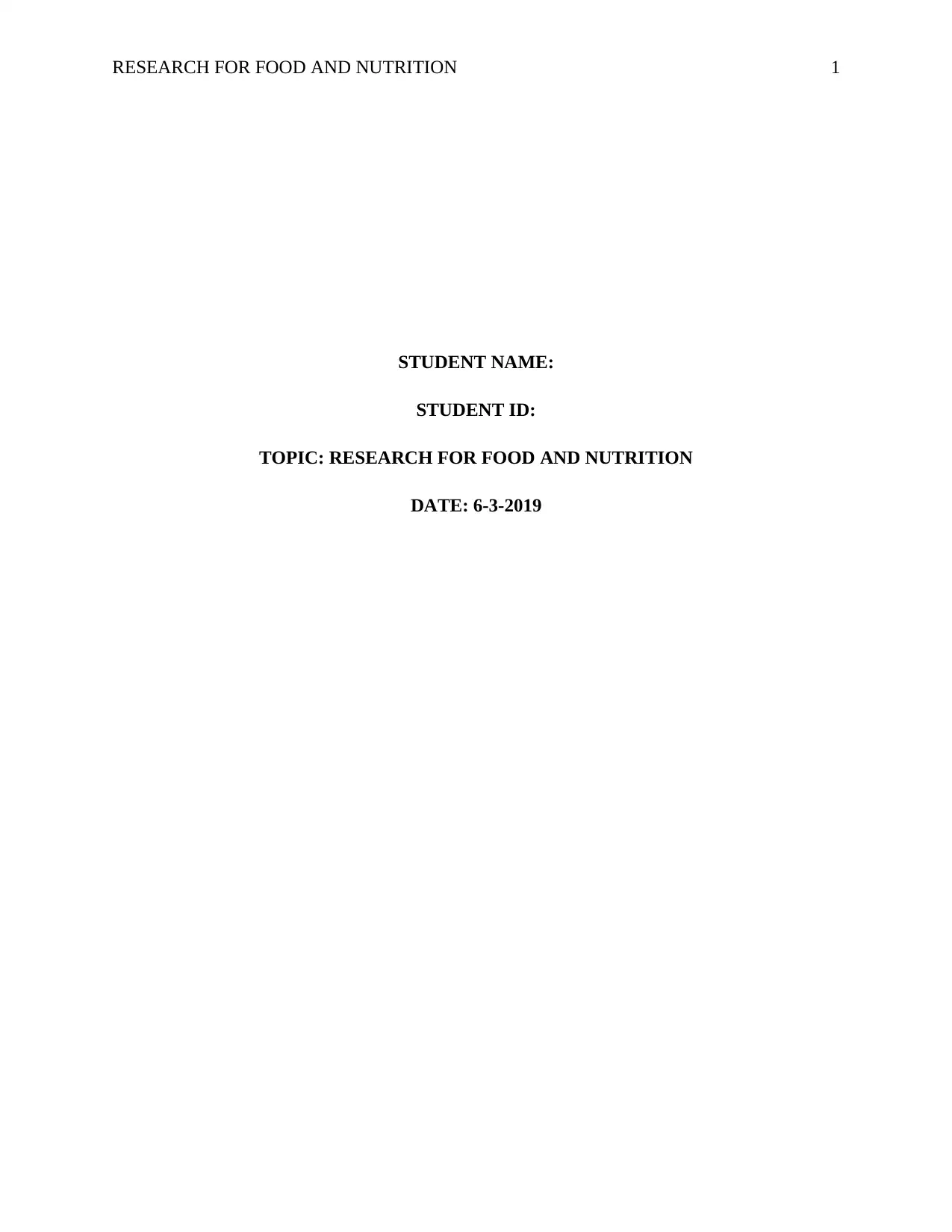
RESEARCH FOR FOOD AND NUTRITION 1
STUDENT NAME:
STUDENT ID:
TOPIC: RESEARCH FOR FOOD AND NUTRITION
DATE: 6-3-2019
STUDENT NAME:
STUDENT ID:
TOPIC: RESEARCH FOR FOOD AND NUTRITION
DATE: 6-3-2019
Secure Best Marks with AI Grader
Need help grading? Try our AI Grader for instant feedback on your assignments.
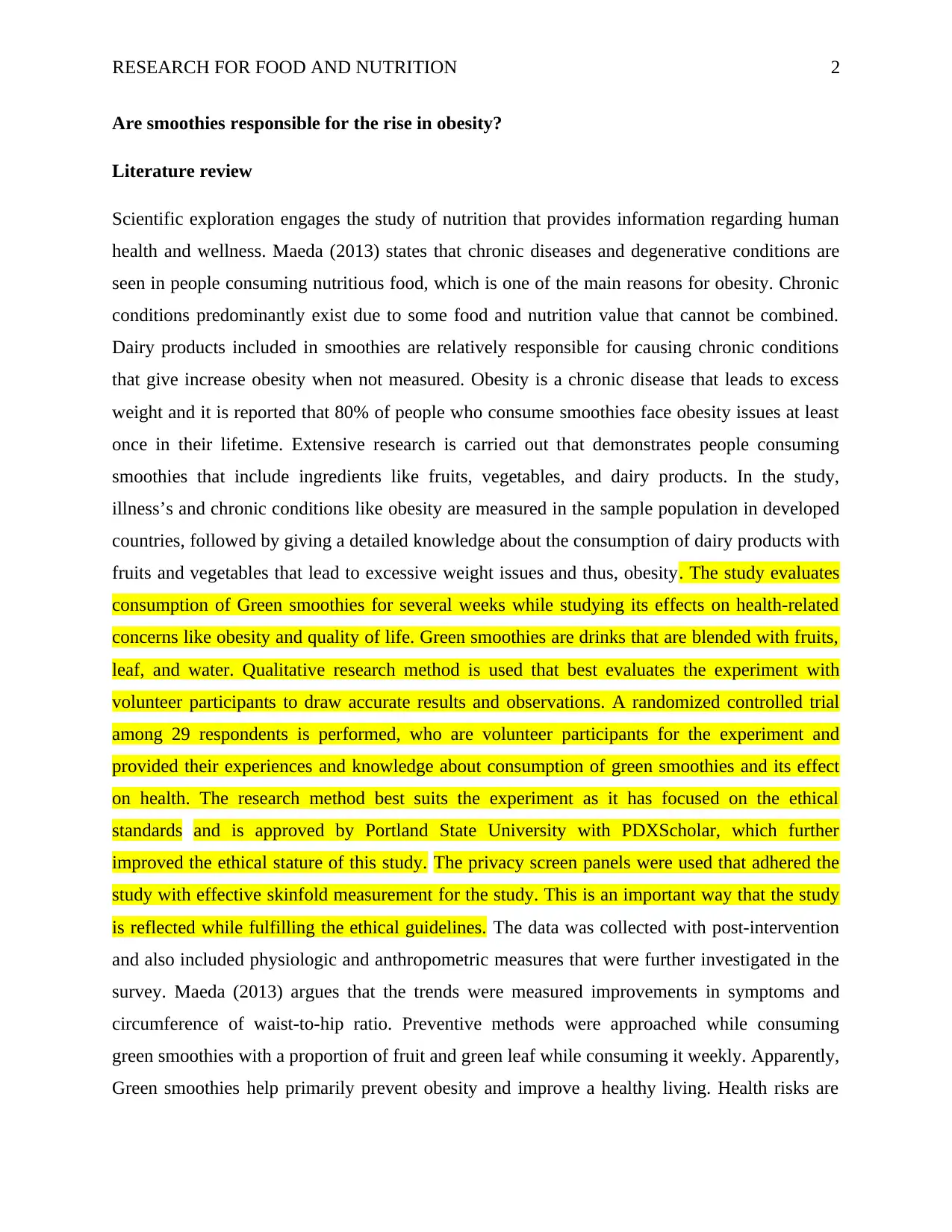
RESEARCH FOR FOOD AND NUTRITION 2
Are smoothies responsible for the rise in obesity?
Literature review
Scientific exploration engages the study of nutrition that provides information regarding human
health and wellness. Maeda (2013) states that chronic diseases and degenerative conditions are
seen in people consuming nutritious food, which is one of the main reasons for obesity. Chronic
conditions predominantly exist due to some food and nutrition value that cannot be combined.
Dairy products included in smoothies are relatively responsible for causing chronic conditions
that give increase obesity when not measured. Obesity is a chronic disease that leads to excess
weight and it is reported that 80% of people who consume smoothies face obesity issues at least
once in their lifetime. Extensive research is carried out that demonstrates people consuming
smoothies that include ingredients like fruits, vegetables, and dairy products. In the study,
illness’s and chronic conditions like obesity are measured in the sample population in developed
countries, followed by giving a detailed knowledge about the consumption of dairy products with
fruits and vegetables that lead to excessive weight issues and thus, obesity. The study evaluates
consumption of Green smoothies for several weeks while studying its effects on health-related
concerns like obesity and quality of life. Green smoothies are drinks that are blended with fruits,
leaf, and water. Qualitative research method is used that best evaluates the experiment with
volunteer participants to draw accurate results and observations. A randomized controlled trial
among 29 respondents is performed, who are volunteer participants for the experiment and
provided their experiences and knowledge about consumption of green smoothies and its effect
on health. The research method best suits the experiment as it has focused on the ethical
standards and is approved by Portland State University with PDXScholar, which further
improved the ethical stature of this study. The privacy screen panels were used that adhered the
study with effective skinfold measurement for the study. This is an important way that the study
is reflected while fulfilling the ethical guidelines. The data was collected with post-intervention
and also included physiologic and anthropometric measures that were further investigated in the
survey. Maeda (2013) argues that the trends were measured improvements in symptoms and
circumference of waist-to-hip ratio. Preventive methods were approached while consuming
green smoothies with a proportion of fruit and green leaf while consuming it weekly. Apparently,
Green smoothies help primarily prevent obesity and improve a healthy living. Health risks are
Are smoothies responsible for the rise in obesity?
Literature review
Scientific exploration engages the study of nutrition that provides information regarding human
health and wellness. Maeda (2013) states that chronic diseases and degenerative conditions are
seen in people consuming nutritious food, which is one of the main reasons for obesity. Chronic
conditions predominantly exist due to some food and nutrition value that cannot be combined.
Dairy products included in smoothies are relatively responsible for causing chronic conditions
that give increase obesity when not measured. Obesity is a chronic disease that leads to excess
weight and it is reported that 80% of people who consume smoothies face obesity issues at least
once in their lifetime. Extensive research is carried out that demonstrates people consuming
smoothies that include ingredients like fruits, vegetables, and dairy products. In the study,
illness’s and chronic conditions like obesity are measured in the sample population in developed
countries, followed by giving a detailed knowledge about the consumption of dairy products with
fruits and vegetables that lead to excessive weight issues and thus, obesity. The study evaluates
consumption of Green smoothies for several weeks while studying its effects on health-related
concerns like obesity and quality of life. Green smoothies are drinks that are blended with fruits,
leaf, and water. Qualitative research method is used that best evaluates the experiment with
volunteer participants to draw accurate results and observations. A randomized controlled trial
among 29 respondents is performed, who are volunteer participants for the experiment and
provided their experiences and knowledge about consumption of green smoothies and its effect
on health. The research method best suits the experiment as it has focused on the ethical
standards and is approved by Portland State University with PDXScholar, which further
improved the ethical stature of this study. The privacy screen panels were used that adhered the
study with effective skinfold measurement for the study. This is an important way that the study
is reflected while fulfilling the ethical guidelines. The data was collected with post-intervention
and also included physiologic and anthropometric measures that were further investigated in the
survey. Maeda (2013) argues that the trends were measured improvements in symptoms and
circumference of waist-to-hip ratio. Preventive methods were approached while consuming
green smoothies with a proportion of fruit and green leaf while consuming it weekly. Apparently,
Green smoothies help primarily prevent obesity and improve a healthy living. Health risks are
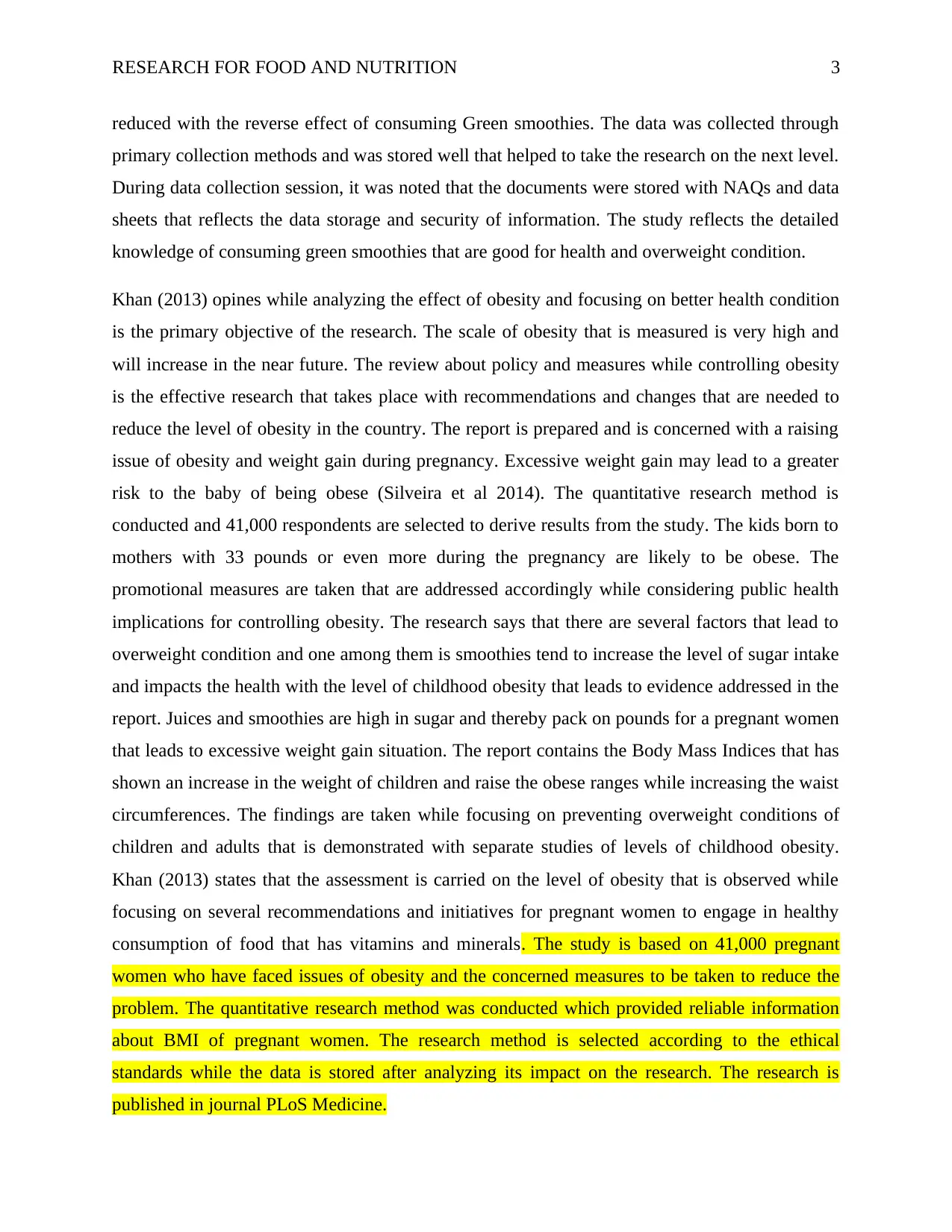
RESEARCH FOR FOOD AND NUTRITION 3
reduced with the reverse effect of consuming Green smoothies. The data was collected through
primary collection methods and was stored well that helped to take the research on the next level.
During data collection session, it was noted that the documents were stored with NAQs and data
sheets that reflects the data storage and security of information. The study reflects the detailed
knowledge of consuming green smoothies that are good for health and overweight condition.
Khan (2013) opines while analyzing the effect of obesity and focusing on better health condition
is the primary objective of the research. The scale of obesity that is measured is very high and
will increase in the near future. The review about policy and measures while controlling obesity
is the effective research that takes place with recommendations and changes that are needed to
reduce the level of obesity in the country. The report is prepared and is concerned with a raising
issue of obesity and weight gain during pregnancy. Excessive weight gain may lead to a greater
risk to the baby of being obese (Silveira et al 2014). The quantitative research method is
conducted and 41,000 respondents are selected to derive results from the study. The kids born to
mothers with 33 pounds or even more during the pregnancy are likely to be obese. The
promotional measures are taken that are addressed accordingly while considering public health
implications for controlling obesity. The research says that there are several factors that lead to
overweight condition and one among them is smoothies tend to increase the level of sugar intake
and impacts the health with the level of childhood obesity that leads to evidence addressed in the
report. Juices and smoothies are high in sugar and thereby pack on pounds for a pregnant women
that leads to excessive weight gain situation. The report contains the Body Mass Indices that has
shown an increase in the weight of children and raise the obese ranges while increasing the waist
circumferences. The findings are taken while focusing on preventing overweight conditions of
children and adults that is demonstrated with separate studies of levels of childhood obesity.
Khan (2013) states that the assessment is carried on the level of obesity that is observed while
focusing on several recommendations and initiatives for pregnant women to engage in healthy
consumption of food that has vitamins and minerals. The study is based on 41,000 pregnant
women who have faced issues of obesity and the concerned measures to be taken to reduce the
problem. The quantitative research method was conducted which provided reliable information
about BMI of pregnant women. The research method is selected according to the ethical
standards while the data is stored after analyzing its impact on the research. The research is
published in journal PLoS Medicine.
reduced with the reverse effect of consuming Green smoothies. The data was collected through
primary collection methods and was stored well that helped to take the research on the next level.
During data collection session, it was noted that the documents were stored with NAQs and data
sheets that reflects the data storage and security of information. The study reflects the detailed
knowledge of consuming green smoothies that are good for health and overweight condition.
Khan (2013) opines while analyzing the effect of obesity and focusing on better health condition
is the primary objective of the research. The scale of obesity that is measured is very high and
will increase in the near future. The review about policy and measures while controlling obesity
is the effective research that takes place with recommendations and changes that are needed to
reduce the level of obesity in the country. The report is prepared and is concerned with a raising
issue of obesity and weight gain during pregnancy. Excessive weight gain may lead to a greater
risk to the baby of being obese (Silveira et al 2014). The quantitative research method is
conducted and 41,000 respondents are selected to derive results from the study. The kids born to
mothers with 33 pounds or even more during the pregnancy are likely to be obese. The
promotional measures are taken that are addressed accordingly while considering public health
implications for controlling obesity. The research says that there are several factors that lead to
overweight condition and one among them is smoothies tend to increase the level of sugar intake
and impacts the health with the level of childhood obesity that leads to evidence addressed in the
report. Juices and smoothies are high in sugar and thereby pack on pounds for a pregnant women
that leads to excessive weight gain situation. The report contains the Body Mass Indices that has
shown an increase in the weight of children and raise the obese ranges while increasing the waist
circumferences. The findings are taken while focusing on preventing overweight conditions of
children and adults that is demonstrated with separate studies of levels of childhood obesity.
Khan (2013) states that the assessment is carried on the level of obesity that is observed while
focusing on several recommendations and initiatives for pregnant women to engage in healthy
consumption of food that has vitamins and minerals. The study is based on 41,000 pregnant
women who have faced issues of obesity and the concerned measures to be taken to reduce the
problem. The quantitative research method was conducted which provided reliable information
about BMI of pregnant women. The research method is selected according to the ethical
standards while the data is stored after analyzing its impact on the research. The research is
published in journal PLoS Medicine.
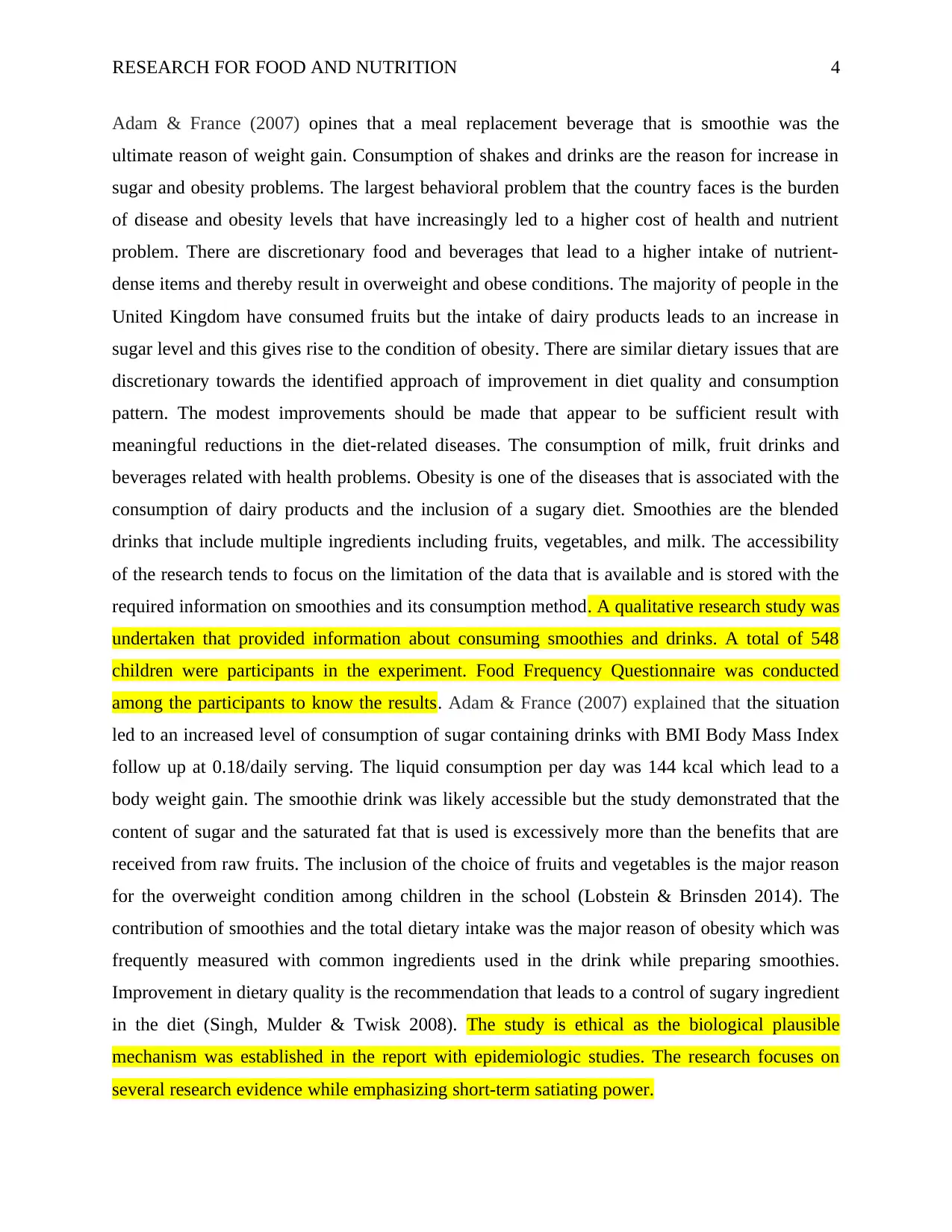
RESEARCH FOR FOOD AND NUTRITION 4
Adam & France (2007) opines that a meal replacement beverage that is smoothie was the
ultimate reason of weight gain. Consumption of shakes and drinks are the reason for increase in
sugar and obesity problems. The largest behavioral problem that the country faces is the burden
of disease and obesity levels that have increasingly led to a higher cost of health and nutrient
problem. There are discretionary food and beverages that lead to a higher intake of nutrient-
dense items and thereby result in overweight and obese conditions. The majority of people in the
United Kingdom have consumed fruits but the intake of dairy products leads to an increase in
sugar level and this gives rise to the condition of obesity. There are similar dietary issues that are
discretionary towards the identified approach of improvement in diet quality and consumption
pattern. The modest improvements should be made that appear to be sufficient result with
meaningful reductions in the diet-related diseases. The consumption of milk, fruit drinks and
beverages related with health problems. Obesity is one of the diseases that is associated with the
consumption of dairy products and the inclusion of a sugary diet. Smoothies are the blended
drinks that include multiple ingredients including fruits, vegetables, and milk. The accessibility
of the research tends to focus on the limitation of the data that is available and is stored with the
required information on smoothies and its consumption method. A qualitative research study was
undertaken that provided information about consuming smoothies and drinks. A total of 548
children were participants in the experiment. Food Frequency Questionnaire was conducted
among the participants to know the results. Adam & France (2007) explained that the situation
led to an increased level of consumption of sugar containing drinks with BMI Body Mass Index
follow up at 0.18/daily serving. The liquid consumption per day was 144 kcal which lead to a
body weight gain. The smoothie drink was likely accessible but the study demonstrated that the
content of sugar and the saturated fat that is used is excessively more than the benefits that are
received from raw fruits. The inclusion of the choice of fruits and vegetables is the major reason
for the overweight condition among children in the school (Lobstein & Brinsden 2014). The
contribution of smoothies and the total dietary intake was the major reason of obesity which was
frequently measured with common ingredients used in the drink while preparing smoothies.
Improvement in dietary quality is the recommendation that leads to a control of sugary ingredient
in the diet (Singh, Mulder & Twisk 2008). The study is ethical as the biological plausible
mechanism was established in the report with epidemiologic studies. The research focuses on
several research evidence while emphasizing short-term satiating power.
Adam & France (2007) opines that a meal replacement beverage that is smoothie was the
ultimate reason of weight gain. Consumption of shakes and drinks are the reason for increase in
sugar and obesity problems. The largest behavioral problem that the country faces is the burden
of disease and obesity levels that have increasingly led to a higher cost of health and nutrient
problem. There are discretionary food and beverages that lead to a higher intake of nutrient-
dense items and thereby result in overweight and obese conditions. The majority of people in the
United Kingdom have consumed fruits but the intake of dairy products leads to an increase in
sugar level and this gives rise to the condition of obesity. There are similar dietary issues that are
discretionary towards the identified approach of improvement in diet quality and consumption
pattern. The modest improvements should be made that appear to be sufficient result with
meaningful reductions in the diet-related diseases. The consumption of milk, fruit drinks and
beverages related with health problems. Obesity is one of the diseases that is associated with the
consumption of dairy products and the inclusion of a sugary diet. Smoothies are the blended
drinks that include multiple ingredients including fruits, vegetables, and milk. The accessibility
of the research tends to focus on the limitation of the data that is available and is stored with the
required information on smoothies and its consumption method. A qualitative research study was
undertaken that provided information about consuming smoothies and drinks. A total of 548
children were participants in the experiment. Food Frequency Questionnaire was conducted
among the participants to know the results. Adam & France (2007) explained that the situation
led to an increased level of consumption of sugar containing drinks with BMI Body Mass Index
follow up at 0.18/daily serving. The liquid consumption per day was 144 kcal which lead to a
body weight gain. The smoothie drink was likely accessible but the study demonstrated that the
content of sugar and the saturated fat that is used is excessively more than the benefits that are
received from raw fruits. The inclusion of the choice of fruits and vegetables is the major reason
for the overweight condition among children in the school (Lobstein & Brinsden 2014). The
contribution of smoothies and the total dietary intake was the major reason of obesity which was
frequently measured with common ingredients used in the drink while preparing smoothies.
Improvement in dietary quality is the recommendation that leads to a control of sugary ingredient
in the diet (Singh, Mulder & Twisk 2008). The study is ethical as the biological plausible
mechanism was established in the report with epidemiologic studies. The research focuses on
several research evidence while emphasizing short-term satiating power.
Secure Best Marks with AI Grader
Need help grading? Try our AI Grader for instant feedback on your assignments.
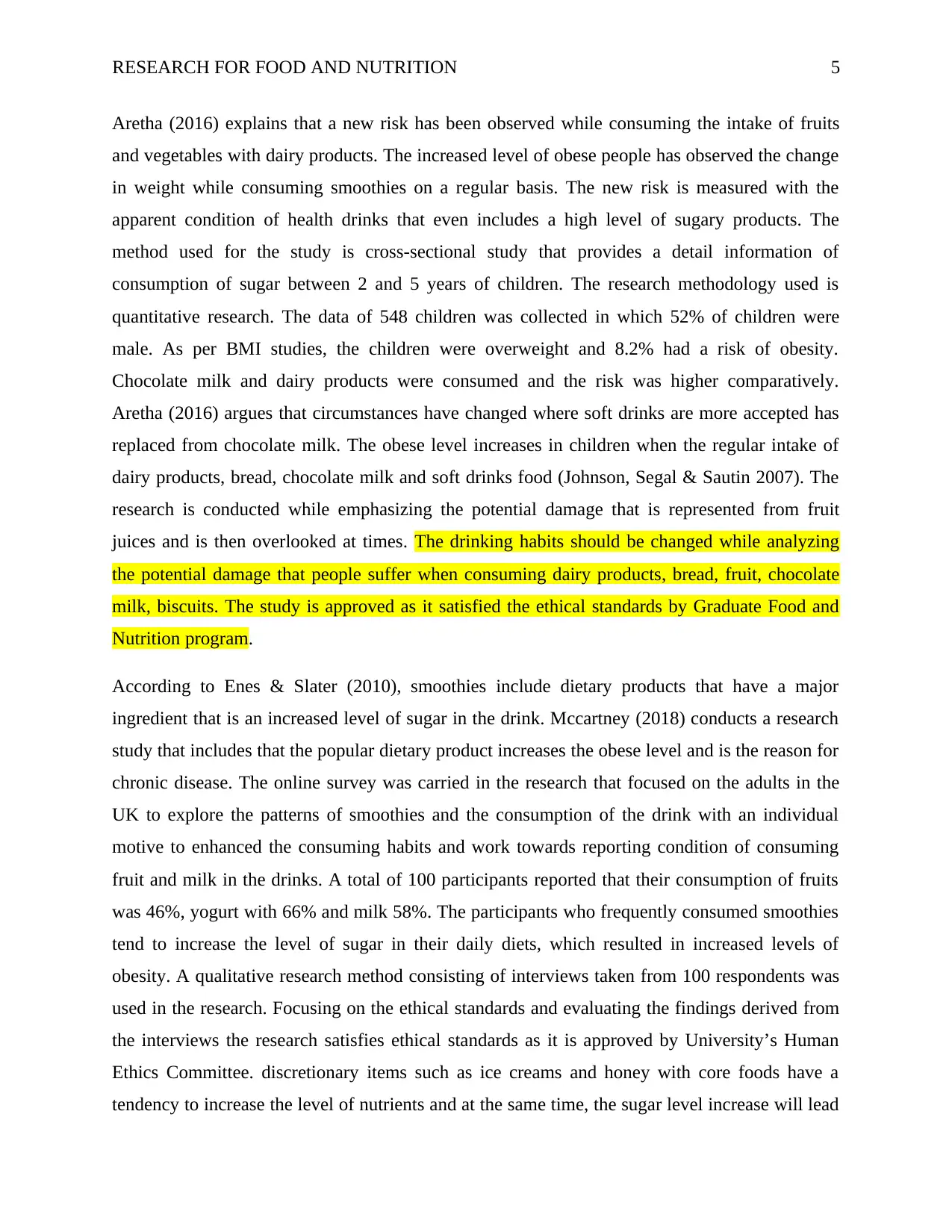
RESEARCH FOR FOOD AND NUTRITION 5
Aretha (2016) explains that a new risk has been observed while consuming the intake of fruits
and vegetables with dairy products. The increased level of obese people has observed the change
in weight while consuming smoothies on a regular basis. The new risk is measured with the
apparent condition of health drinks that even includes a high level of sugary products. The
method used for the study is cross-sectional study that provides a detail information of
consumption of sugar between 2 and 5 years of children. The research methodology used is
quantitative research. The data of 548 children was collected in which 52% of children were
male. As per BMI studies, the children were overweight and 8.2% had a risk of obesity.
Chocolate milk and dairy products were consumed and the risk was higher comparatively.
Aretha (2016) argues that circumstances have changed where soft drinks are more accepted has
replaced from chocolate milk. The obese level increases in children when the regular intake of
dairy products, bread, chocolate milk and soft drinks food (Johnson, Segal & Sautin 2007). The
research is conducted while emphasizing the potential damage that is represented from fruit
juices and is then overlooked at times. The drinking habits should be changed while analyzing
the potential damage that people suffer when consuming dairy products, bread, fruit, chocolate
milk, biscuits. The study is approved as it satisfied the ethical standards by Graduate Food and
Nutrition program.
According to Enes & Slater (2010), smoothies include dietary products that have a major
ingredient that is an increased level of sugar in the drink. Mccartney (2018) conducts a research
study that includes that the popular dietary product increases the obese level and is the reason for
chronic disease. The online survey was carried in the research that focused on the adults in the
UK to explore the patterns of smoothies and the consumption of the drink with an individual
motive to enhanced the consuming habits and work towards reporting condition of consuming
fruit and milk in the drinks. A total of 100 participants reported that their consumption of fruits
was 46%, yogurt with 66% and milk 58%. The participants who frequently consumed smoothies
tend to increase the level of sugar in their daily diets, which resulted in increased levels of
obesity. A qualitative research method consisting of interviews taken from 100 respondents was
used in the research. Focusing on the ethical standards and evaluating the findings derived from
the interviews the research satisfies ethical standards as it is approved by University’s Human
Ethics Committee. discretionary items such as ice creams and honey with core foods have a
tendency to increase the level of nutrients and at the same time, the sugar level increase will lead
Aretha (2016) explains that a new risk has been observed while consuming the intake of fruits
and vegetables with dairy products. The increased level of obese people has observed the change
in weight while consuming smoothies on a regular basis. The new risk is measured with the
apparent condition of health drinks that even includes a high level of sugary products. The
method used for the study is cross-sectional study that provides a detail information of
consumption of sugar between 2 and 5 years of children. The research methodology used is
quantitative research. The data of 548 children was collected in which 52% of children were
male. As per BMI studies, the children were overweight and 8.2% had a risk of obesity.
Chocolate milk and dairy products were consumed and the risk was higher comparatively.
Aretha (2016) argues that circumstances have changed where soft drinks are more accepted has
replaced from chocolate milk. The obese level increases in children when the regular intake of
dairy products, bread, chocolate milk and soft drinks food (Johnson, Segal & Sautin 2007). The
research is conducted while emphasizing the potential damage that is represented from fruit
juices and is then overlooked at times. The drinking habits should be changed while analyzing
the potential damage that people suffer when consuming dairy products, bread, fruit, chocolate
milk, biscuits. The study is approved as it satisfied the ethical standards by Graduate Food and
Nutrition program.
According to Enes & Slater (2010), smoothies include dietary products that have a major
ingredient that is an increased level of sugar in the drink. Mccartney (2018) conducts a research
study that includes that the popular dietary product increases the obese level and is the reason for
chronic disease. The online survey was carried in the research that focused on the adults in the
UK to explore the patterns of smoothies and the consumption of the drink with an individual
motive to enhanced the consuming habits and work towards reporting condition of consuming
fruit and milk in the drinks. A total of 100 participants reported that their consumption of fruits
was 46%, yogurt with 66% and milk 58%. The participants who frequently consumed smoothies
tend to increase the level of sugar in their daily diets, which resulted in increased levels of
obesity. A qualitative research method consisting of interviews taken from 100 respondents was
used in the research. Focusing on the ethical standards and evaluating the findings derived from
the interviews the research satisfies ethical standards as it is approved by University’s Human
Ethics Committee. discretionary items such as ice creams and honey with core foods have a
tendency to increase the level of nutrients and at the same time, the sugar level increase will lead
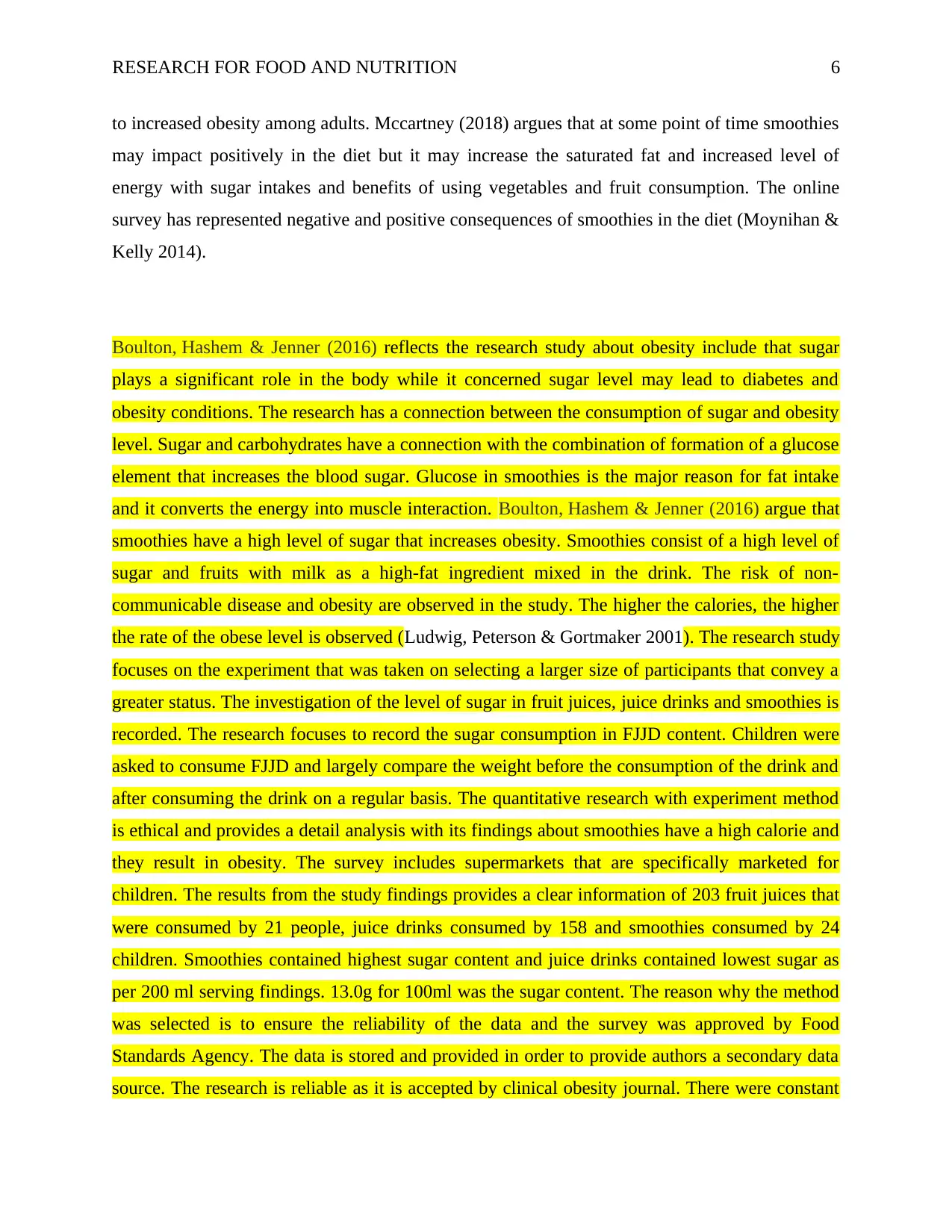
RESEARCH FOR FOOD AND NUTRITION 6
to increased obesity among adults. Mccartney (2018) argues that at some point of time smoothies
may impact positively in the diet but it may increase the saturated fat and increased level of
energy with sugar intakes and benefits of using vegetables and fruit consumption. The online
survey has represented negative and positive consequences of smoothies in the diet (Moynihan &
Kelly 2014).
Boulton, Hashem & Jenner (2016) reflects the research study about obesity include that sugar
plays a significant role in the body while it concerned sugar level may lead to diabetes and
obesity conditions. The research has a connection between the consumption of sugar and obesity
level. Sugar and carbohydrates have a connection with the combination of formation of a glucose
element that increases the blood sugar. Glucose in smoothies is the major reason for fat intake
and it converts the energy into muscle interaction. Boulton, Hashem & Jenner (2016) argue that
smoothies have a high level of sugar that increases obesity. Smoothies consist of a high level of
sugar and fruits with milk as a high-fat ingredient mixed in the drink. The risk of non-
communicable disease and obesity are observed in the study. The higher the calories, the higher
the rate of the obese level is observed (Ludwig, Peterson & Gortmaker 2001). The research study
focuses on the experiment that was taken on selecting a larger size of participants that convey a
greater status. The investigation of the level of sugar in fruit juices, juice drinks and smoothies is
recorded. The research focuses to record the sugar consumption in FJJD content. Children were
asked to consume FJJD and largely compare the weight before the consumption of the drink and
after consuming the drink on a regular basis. The quantitative research with experiment method
is ethical and provides a detail analysis with its findings about smoothies have a high calorie and
they result in obesity. The survey includes supermarkets that are specifically marketed for
children. The results from the study findings provides a clear information of 203 fruit juices that
were consumed by 21 people, juice drinks consumed by 158 and smoothies consumed by 24
children. Smoothies contained highest sugar content and juice drinks contained lowest sugar as
per 200 ml serving findings. 13.0g for 100ml was the sugar content. The reason why the method
was selected is to ensure the reliability of the data and the survey was approved by Food
Standards Agency. The data is stored and provided in order to provide authors a secondary data
source. The research is reliable as it is accepted by clinical obesity journal. There were constant
to increased obesity among adults. Mccartney (2018) argues that at some point of time smoothies
may impact positively in the diet but it may increase the saturated fat and increased level of
energy with sugar intakes and benefits of using vegetables and fruit consumption. The online
survey has represented negative and positive consequences of smoothies in the diet (Moynihan &
Kelly 2014).
Boulton, Hashem & Jenner (2016) reflects the research study about obesity include that sugar
plays a significant role in the body while it concerned sugar level may lead to diabetes and
obesity conditions. The research has a connection between the consumption of sugar and obesity
level. Sugar and carbohydrates have a connection with the combination of formation of a glucose
element that increases the blood sugar. Glucose in smoothies is the major reason for fat intake
and it converts the energy into muscle interaction. Boulton, Hashem & Jenner (2016) argue that
smoothies have a high level of sugar that increases obesity. Smoothies consist of a high level of
sugar and fruits with milk as a high-fat ingredient mixed in the drink. The risk of non-
communicable disease and obesity are observed in the study. The higher the calories, the higher
the rate of the obese level is observed (Ludwig, Peterson & Gortmaker 2001). The research study
focuses on the experiment that was taken on selecting a larger size of participants that convey a
greater status. The investigation of the level of sugar in fruit juices, juice drinks and smoothies is
recorded. The research focuses to record the sugar consumption in FJJD content. Children were
asked to consume FJJD and largely compare the weight before the consumption of the drink and
after consuming the drink on a regular basis. The quantitative research with experiment method
is ethical and provides a detail analysis with its findings about smoothies have a high calorie and
they result in obesity. The survey includes supermarkets that are specifically marketed for
children. The results from the study findings provides a clear information of 203 fruit juices that
were consumed by 21 people, juice drinks consumed by 158 and smoothies consumed by 24
children. Smoothies contained highest sugar content and juice drinks contained lowest sugar as
per 200 ml serving findings. 13.0g for 100ml was the sugar content. The reason why the method
was selected is to ensure the reliability of the data and the survey was approved by Food
Standards Agency. The data is stored and provided in order to provide authors a secondary data
source. The research is reliable as it is accepted by clinical obesity journal. There were constant
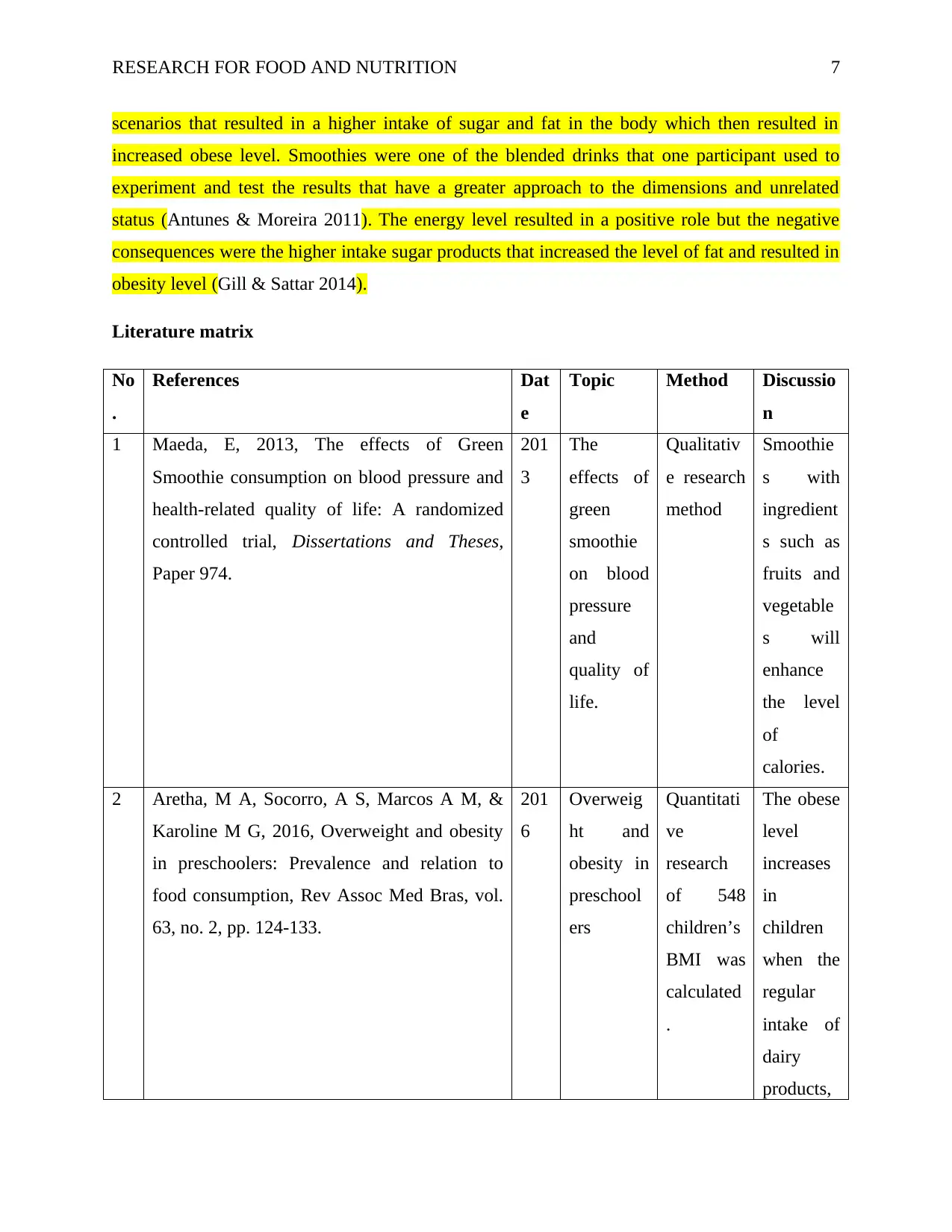
RESEARCH FOR FOOD AND NUTRITION 7
scenarios that resulted in a higher intake of sugar and fat in the body which then resulted in
increased obese level. Smoothies were one of the blended drinks that one participant used to
experiment and test the results that have a greater approach to the dimensions and unrelated
status (Antunes & Moreira 2011). The energy level resulted in a positive role but the negative
consequences were the higher intake sugar products that increased the level of fat and resulted in
obesity level (Gill & Sattar 2014).
Literature matrix
No
.
References Dat
e
Topic Method Discussio
n
1 Maeda, E, 2013, The effects of Green
Smoothie consumption on blood pressure and
health-related quality of life: A randomized
controlled trial, Dissertations and Theses,
Paper 974.
201
3
The
effects of
green
smoothie
on blood
pressure
and
quality of
life.
Qualitativ
e research
method
Smoothie
s with
ingredient
s such as
fruits and
vegetable
s will
enhance
the level
of
calories.
2 Aretha, M A, Socorro, A S, Marcos A M, &
Karoline M G, 2016, Overweight and obesity
in preschoolers: Prevalence and relation to
food consumption, Rev Assoc Med Bras, vol.
63, no. 2, pp. 124-133.
201
6
Overweig
ht and
obesity in
preschool
ers
Quantitati
ve
research
of 548
children’s
BMI was
calculated
.
The obese
level
increases
in
children
when the
regular
intake of
dairy
products,
scenarios that resulted in a higher intake of sugar and fat in the body which then resulted in
increased obese level. Smoothies were one of the blended drinks that one participant used to
experiment and test the results that have a greater approach to the dimensions and unrelated
status (Antunes & Moreira 2011). The energy level resulted in a positive role but the negative
consequences were the higher intake sugar products that increased the level of fat and resulted in
obesity level (Gill & Sattar 2014).
Literature matrix
No
.
References Dat
e
Topic Method Discussio
n
1 Maeda, E, 2013, The effects of Green
Smoothie consumption on blood pressure and
health-related quality of life: A randomized
controlled trial, Dissertations and Theses,
Paper 974.
201
3
The
effects of
green
smoothie
on blood
pressure
and
quality of
life.
Qualitativ
e research
method
Smoothie
s with
ingredient
s such as
fruits and
vegetable
s will
enhance
the level
of
calories.
2 Aretha, M A, Socorro, A S, Marcos A M, &
Karoline M G, 2016, Overweight and obesity
in preschoolers: Prevalence and relation to
food consumption, Rev Assoc Med Bras, vol.
63, no. 2, pp. 124-133.
201
6
Overweig
ht and
obesity in
preschool
ers
Quantitati
ve
research
of 548
children’s
BMI was
calculated
.
The obese
level
increases
in
children
when the
regular
intake of
dairy
products,
Paraphrase This Document
Need a fresh take? Get an instant paraphrase of this document with our AI Paraphraser
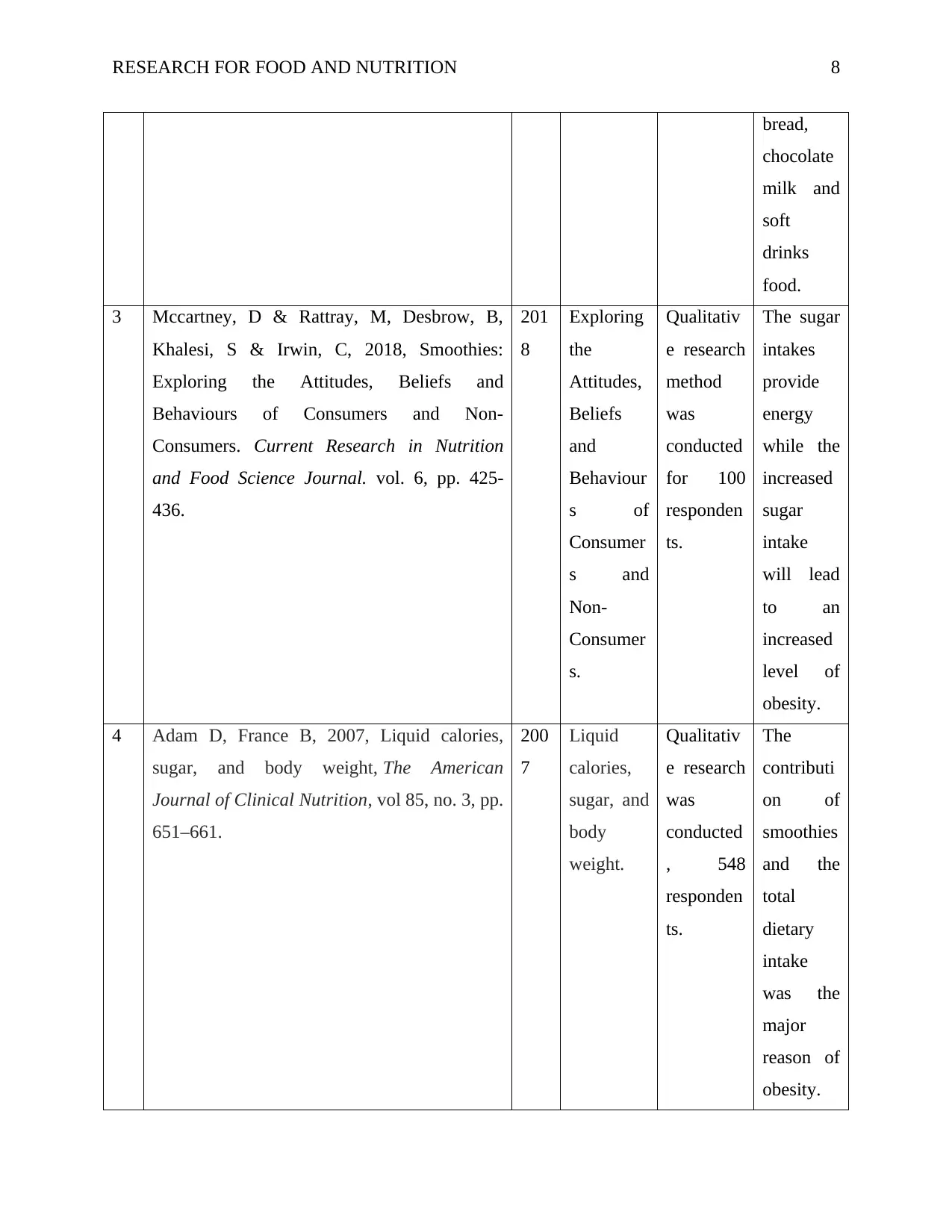
RESEARCH FOR FOOD AND NUTRITION 8
bread,
chocolate
milk and
soft
drinks
food.
3 Mccartney, D & Rattray, M, Desbrow, B,
Khalesi, S & Irwin, C, 2018, Smoothies:
Exploring the Attitudes, Beliefs and
Behaviours of Consumers and Non-
Consumers. Current Research in Nutrition
and Food Science Journal. vol. 6, pp. 425-
436.
201
8
Exploring
the
Attitudes,
Beliefs
and
Behaviour
s of
Consumer
s and
Non-
Consumer
s.
Qualitativ
e research
method
was
conducted
for 100
responden
ts.
The sugar
intakes
provide
energy
while the
increased
sugar
intake
will lead
to an
increased
level of
obesity.
4 Adam D, France B, 2007, Liquid calories,
sugar, and body weight, The American
Journal of Clinical Nutrition, vol 85, no. 3, pp.
651–661.
200
7
Liquid
calories,
sugar, and
body
weight.
Qualitativ
e research
was
conducted
, 548
responden
ts.
The
contributi
on of
smoothies
and the
total
dietary
intake
was the
major
reason of
obesity.
bread,
chocolate
milk and
soft
drinks
food.
3 Mccartney, D & Rattray, M, Desbrow, B,
Khalesi, S & Irwin, C, 2018, Smoothies:
Exploring the Attitudes, Beliefs and
Behaviours of Consumers and Non-
Consumers. Current Research in Nutrition
and Food Science Journal. vol. 6, pp. 425-
436.
201
8
Exploring
the
Attitudes,
Beliefs
and
Behaviour
s of
Consumer
s and
Non-
Consumer
s.
Qualitativ
e research
method
was
conducted
for 100
responden
ts.
The sugar
intakes
provide
energy
while the
increased
sugar
intake
will lead
to an
increased
level of
obesity.
4 Adam D, France B, 2007, Liquid calories,
sugar, and body weight, The American
Journal of Clinical Nutrition, vol 85, no. 3, pp.
651–661.
200
7
Liquid
calories,
sugar, and
body
weight.
Qualitativ
e research
was
conducted
, 548
responden
ts.
The
contributi
on of
smoothies
and the
total
dietary
intake
was the
major
reason of
obesity.
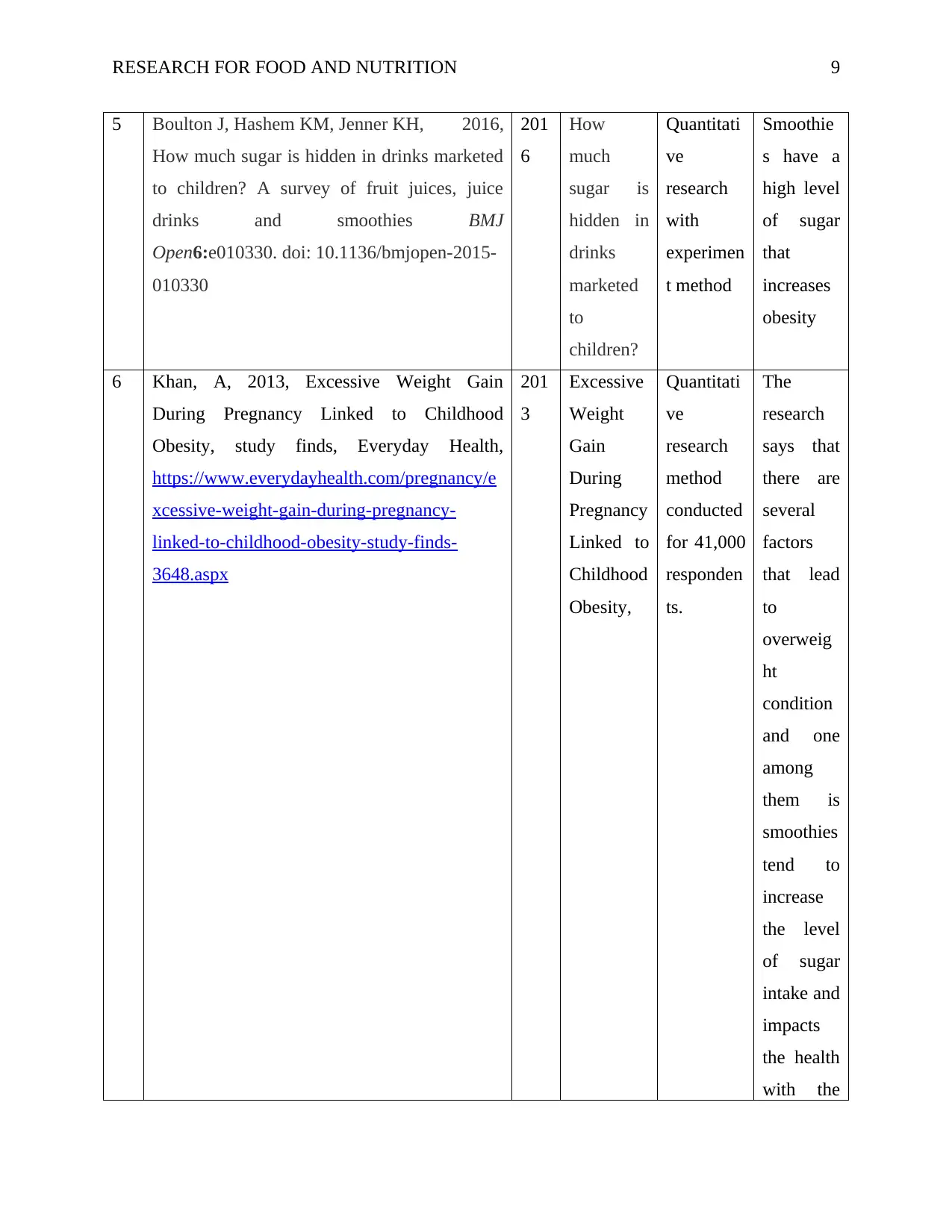
RESEARCH FOR FOOD AND NUTRITION 9
5 Boulton J, Hashem KM, Jenner KH, 2016,
How much sugar is hidden in drinks marketed
to children? A survey of fruit juices, juice
drinks and smoothies BMJ
Open6:e010330. doi: 10.1136/bmjopen-2015-
010330
201
6
How
much
sugar is
hidden in
drinks
marketed
to
children?
Quantitati
ve
research
with
experimen
t method
Smoothie
s have a
high level
of sugar
that
increases
obesity
6 Khan, A, 2013, Excessive Weight Gain
During Pregnancy Linked to Childhood
Obesity, study finds, Everyday Health,
https://www.everydayhealth.com/pregnancy/e
xcessive-weight-gain-during-pregnancy-
linked-to-childhood-obesity-study-finds-
3648.aspx
201
3
Excessive
Weight
Gain
During
Pregnancy
Linked to
Childhood
Obesity,
Quantitati
ve
research
method
conducted
for 41,000
responden
ts.
The
research
says that
there are
several
factors
that lead
to
overweig
ht
condition
and one
among
them is
smoothies
tend to
increase
the level
of sugar
intake and
impacts
the health
with the
5 Boulton J, Hashem KM, Jenner KH, 2016,
How much sugar is hidden in drinks marketed
to children? A survey of fruit juices, juice
drinks and smoothies BMJ
Open6:e010330. doi: 10.1136/bmjopen-2015-
010330
201
6
How
much
sugar is
hidden in
drinks
marketed
to
children?
Quantitati
ve
research
with
experimen
t method
Smoothie
s have a
high level
of sugar
that
increases
obesity
6 Khan, A, 2013, Excessive Weight Gain
During Pregnancy Linked to Childhood
Obesity, study finds, Everyday Health,
https://www.everydayhealth.com/pregnancy/e
xcessive-weight-gain-during-pregnancy-
linked-to-childhood-obesity-study-finds-
3648.aspx
201
3
Excessive
Weight
Gain
During
Pregnancy
Linked to
Childhood
Obesity,
Quantitati
ve
research
method
conducted
for 41,000
responden
ts.
The
research
says that
there are
several
factors
that lead
to
overweig
ht
condition
and one
among
them is
smoothies
tend to
increase
the level
of sugar
intake and
impacts
the health
with the
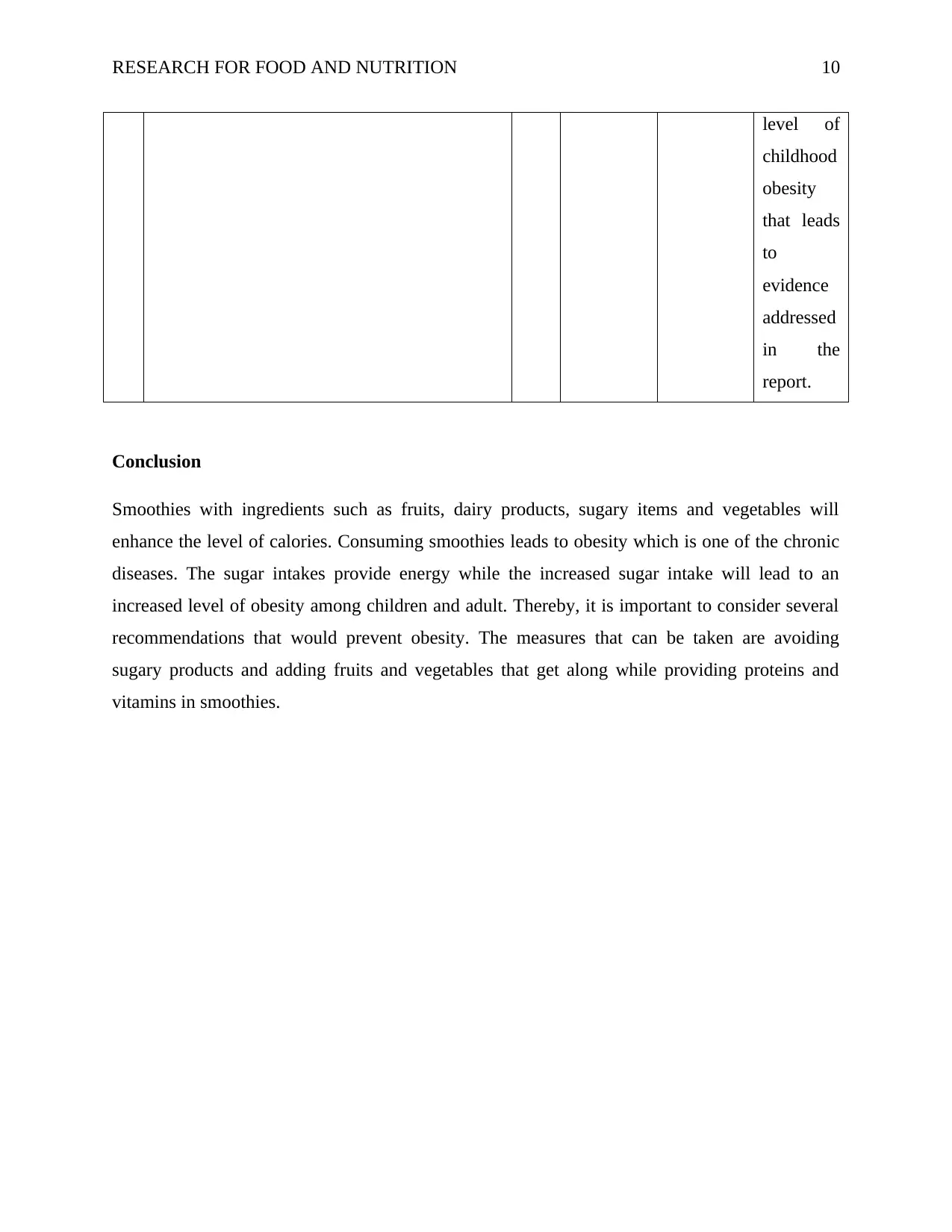
RESEARCH FOR FOOD AND NUTRITION 10
level of
childhood
obesity
that leads
to
evidence
addressed
in the
report.
Conclusion
Smoothies with ingredients such as fruits, dairy products, sugary items and vegetables will
enhance the level of calories. Consuming smoothies leads to obesity which is one of the chronic
diseases. The sugar intakes provide energy while the increased sugar intake will lead to an
increased level of obesity among children and adult. Thereby, it is important to consider several
recommendations that would prevent obesity. The measures that can be taken are avoiding
sugary products and adding fruits and vegetables that get along while providing proteins and
vitamins in smoothies.
level of
childhood
obesity
that leads
to
evidence
addressed
in the
report.
Conclusion
Smoothies with ingredients such as fruits, dairy products, sugary items and vegetables will
enhance the level of calories. Consuming smoothies leads to obesity which is one of the chronic
diseases. The sugar intakes provide energy while the increased sugar intake will lead to an
increased level of obesity among children and adult. Thereby, it is important to consider several
recommendations that would prevent obesity. The measures that can be taken are avoiding
sugary products and adding fruits and vegetables that get along while providing proteins and
vitamins in smoothies.
Secure Best Marks with AI Grader
Need help grading? Try our AI Grader for instant feedback on your assignments.
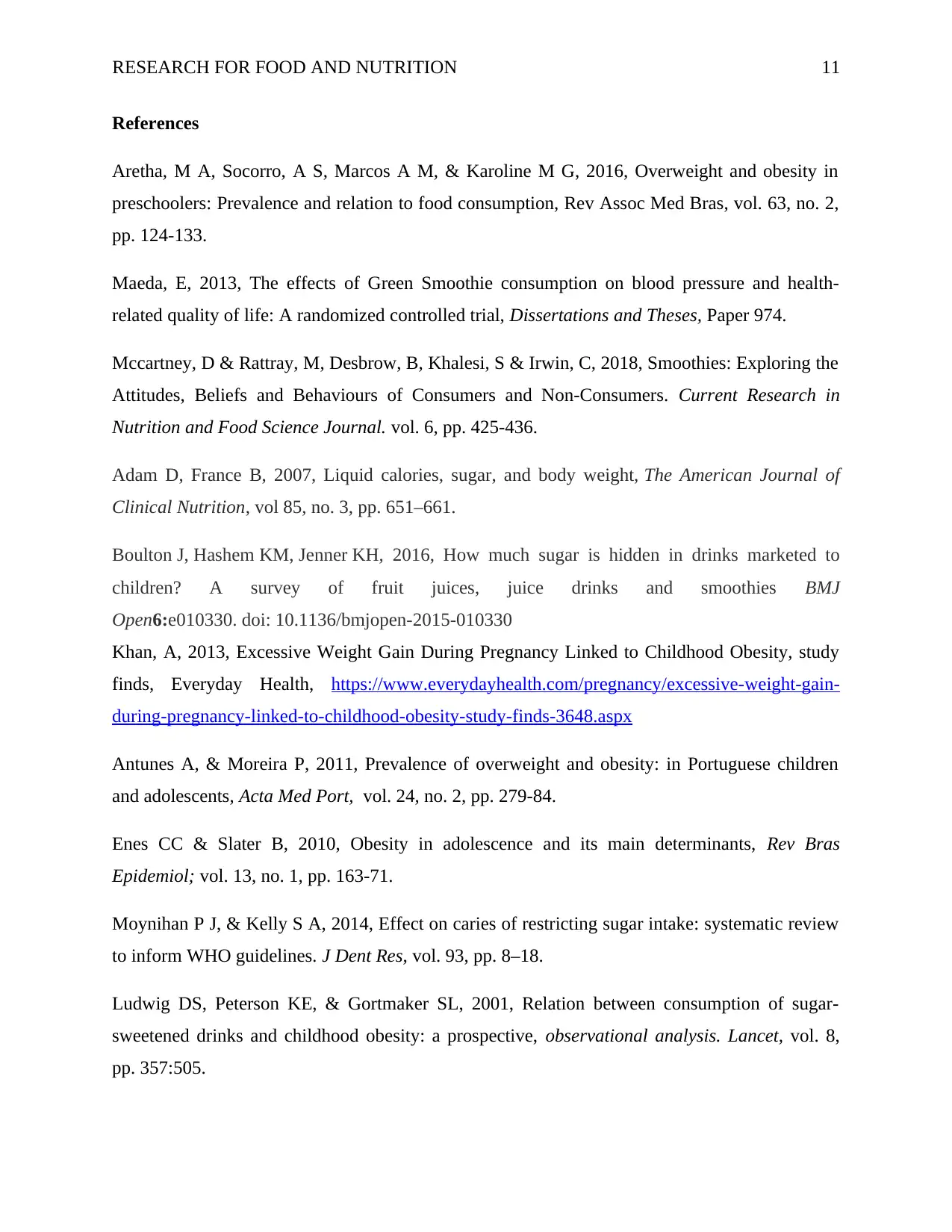
RESEARCH FOR FOOD AND NUTRITION 11
References
Aretha, M A, Socorro, A S, Marcos A M, & Karoline M G, 2016, Overweight and obesity in
preschoolers: Prevalence and relation to food consumption, Rev Assoc Med Bras, vol. 63, no. 2,
pp. 124-133.
Maeda, E, 2013, The effects of Green Smoothie consumption on blood pressure and health-
related quality of life: A randomized controlled trial, Dissertations and Theses, Paper 974.
Mccartney, D & Rattray, M, Desbrow, B, Khalesi, S & Irwin, C, 2018, Smoothies: Exploring the
Attitudes, Beliefs and Behaviours of Consumers and Non-Consumers. Current Research in
Nutrition and Food Science Journal. vol. 6, pp. 425-436.
Adam D, France B, 2007, Liquid calories, sugar, and body weight, The American Journal of
Clinical Nutrition, vol 85, no. 3, pp. 651–661.
Boulton J, Hashem KM, Jenner KH, 2016, How much sugar is hidden in drinks marketed to
children? A survey of fruit juices, juice drinks and smoothies BMJ
Open6:e010330. doi: 10.1136/bmjopen-2015-010330
Khan, A, 2013, Excessive Weight Gain During Pregnancy Linked to Childhood Obesity, study
finds, Everyday Health, https://www.everydayhealth.com/pregnancy/excessive-weight-gain-
during-pregnancy-linked-to-childhood-obesity-study-finds-3648.aspx
Antunes A, & Moreira P, 2011, Prevalence of overweight and obesity: in Portuguese children
and adolescents, Acta Med Port, vol. 24, no. 2, pp. 279-84.
Enes CC & Slater B, 2010, Obesity in adolescence and its main determinants, Rev Bras
Epidemiol; vol. 13, no. 1, pp. 163-71.
Moynihan P J, & Kelly S A, 2014, Effect on caries of restricting sugar intake: systematic review
to inform WHO guidelines. J Dent Res, vol. 93, pp. 8–18.
Ludwig DS, Peterson KE, & Gortmaker SL, 2001, Relation between consumption of sugar-
sweetened drinks and childhood obesity: a prospective, observational analysis. Lancet, vol. 8,
pp. 357:505.
References
Aretha, M A, Socorro, A S, Marcos A M, & Karoline M G, 2016, Overweight and obesity in
preschoolers: Prevalence and relation to food consumption, Rev Assoc Med Bras, vol. 63, no. 2,
pp. 124-133.
Maeda, E, 2013, The effects of Green Smoothie consumption on blood pressure and health-
related quality of life: A randomized controlled trial, Dissertations and Theses, Paper 974.
Mccartney, D & Rattray, M, Desbrow, B, Khalesi, S & Irwin, C, 2018, Smoothies: Exploring the
Attitudes, Beliefs and Behaviours of Consumers and Non-Consumers. Current Research in
Nutrition and Food Science Journal. vol. 6, pp. 425-436.
Adam D, France B, 2007, Liquid calories, sugar, and body weight, The American Journal of
Clinical Nutrition, vol 85, no. 3, pp. 651–661.
Boulton J, Hashem KM, Jenner KH, 2016, How much sugar is hidden in drinks marketed to
children? A survey of fruit juices, juice drinks and smoothies BMJ
Open6:e010330. doi: 10.1136/bmjopen-2015-010330
Khan, A, 2013, Excessive Weight Gain During Pregnancy Linked to Childhood Obesity, study
finds, Everyday Health, https://www.everydayhealth.com/pregnancy/excessive-weight-gain-
during-pregnancy-linked-to-childhood-obesity-study-finds-3648.aspx
Antunes A, & Moreira P, 2011, Prevalence of overweight and obesity: in Portuguese children
and adolescents, Acta Med Port, vol. 24, no. 2, pp. 279-84.
Enes CC & Slater B, 2010, Obesity in adolescence and its main determinants, Rev Bras
Epidemiol; vol. 13, no. 1, pp. 163-71.
Moynihan P J, & Kelly S A, 2014, Effect on caries of restricting sugar intake: systematic review
to inform WHO guidelines. J Dent Res, vol. 93, pp. 8–18.
Ludwig DS, Peterson KE, & Gortmaker SL, 2001, Relation between consumption of sugar-
sweetened drinks and childhood obesity: a prospective, observational analysis. Lancet, vol. 8,
pp. 357:505.
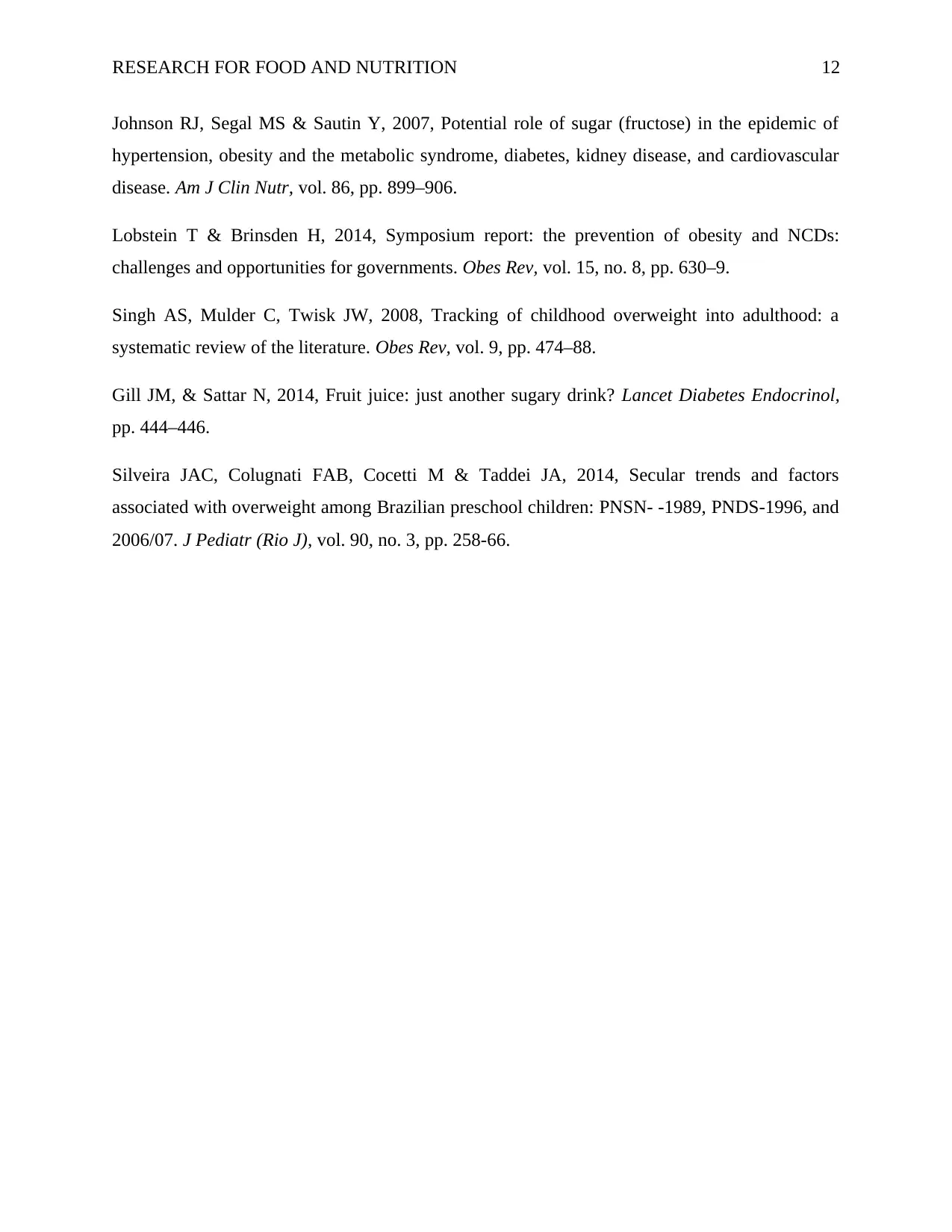
RESEARCH FOR FOOD AND NUTRITION 12
Johnson RJ, Segal MS & Sautin Y, 2007, Potential role of sugar (fructose) in the epidemic of
hypertension, obesity and the metabolic syndrome, diabetes, kidney disease, and cardiovascular
disease. Am J Clin Nutr, vol. 86, pp. 899–906.
Lobstein T & Brinsden H, 2014, Symposium report: the prevention of obesity and NCDs:
challenges and opportunities for governments. Obes Rev, vol. 15, no. 8, pp. 630–9.
Singh AS, Mulder C, Twisk JW, 2008, Tracking of childhood overweight into adulthood: a
systematic review of the literature. Obes Rev, vol. 9, pp. 474–88.
Gill JM, & Sattar N, 2014, Fruit juice: just another sugary drink? Lancet Diabetes Endocrinol,
pp. 444–446.
Silveira JAC, Colugnati FAB, Cocetti M & Taddei JA, 2014, Secular trends and factors
associated with overweight among Brazilian preschool children: PNSN- -1989, PNDS-1996, and
2006/07. J Pediatr (Rio J), vol. 90, no. 3, pp. 258-66.
Johnson RJ, Segal MS & Sautin Y, 2007, Potential role of sugar (fructose) in the epidemic of
hypertension, obesity and the metabolic syndrome, diabetes, kidney disease, and cardiovascular
disease. Am J Clin Nutr, vol. 86, pp. 899–906.
Lobstein T & Brinsden H, 2014, Symposium report: the prevention of obesity and NCDs:
challenges and opportunities for governments. Obes Rev, vol. 15, no. 8, pp. 630–9.
Singh AS, Mulder C, Twisk JW, 2008, Tracking of childhood overweight into adulthood: a
systematic review of the literature. Obes Rev, vol. 9, pp. 474–88.
Gill JM, & Sattar N, 2014, Fruit juice: just another sugary drink? Lancet Diabetes Endocrinol,
pp. 444–446.
Silveira JAC, Colugnati FAB, Cocetti M & Taddei JA, 2014, Secular trends and factors
associated with overweight among Brazilian preschool children: PNSN- -1989, PNDS-1996, and
2006/07. J Pediatr (Rio J), vol. 90, no. 3, pp. 258-66.
1 out of 12
Related Documents
Your All-in-One AI-Powered Toolkit for Academic Success.
+13062052269
info@desklib.com
Available 24*7 on WhatsApp / Email
![[object Object]](/_next/static/media/star-bottom.7253800d.svg)
Unlock your academic potential
© 2024 | Zucol Services PVT LTD | All rights reserved.





